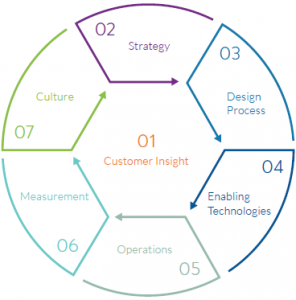The seventh (and final!) of the seven customer experience (CX) dimensions discussed in Perficient Digital’s CX guide is Culture. Even though it comes at the end, numerically, if you look at the diagram, it leads right back into strategy and the rest of the dimensions. That’s because it’s culture that actually keeps the CX wheel turning. If your culture isn’t structured to support CX, none of what you do in the other dimensions will sustain.
As Perficient Digital’s guide puts it: “A thoughtful plan serves as the foundation of CX improvement – and technology and operations play a critical role – but the soul of the CX experience is the culture of your organization.”
Customer-Centric Culture
Your company’s culture is the shared attitudes, beliefs, and values held by leadership and employees, which are demonstrated through their actions. To create a customer-centric culture, it takes effort across the organization, from top to bottom. While leaders are responsible for the oversight of this CX focus, each employee needs to be enabled and encouraged to make customer-centric decisions in their daily work.
CX leaders strongly agree with these culture-building principles:
- Leadership actively supports CX efforts and results
- Employees are empowered to create a memorable CX
- Key functional groups share many of the same CX goals
- Employees have sufficient skills and experience to execute the CX strategy
- The organization is willing to take risks and understands that some projects will fail
- Financial incentives and career advancement opportunities are properly aligned with CX key performance indicators (KPIs)
- CX feedback and metrics are reviewed with employees on a regular basis
Best Practice: Evaluate Your Organizational Structure
CX leaders understand that their organization must continually adapt to thrive in a customer-centric world. We strongly recommend that your management team discuss these three issues:
- What is our management process to balance our corporate CX goals with functional group goals?
- Are we modifying our job roles to consider the CX tasks and technology skills that are necessary?
- Do we need to change our organizational structure to break down silos and improve cross-functional collaboration?
In the final post in this series, I’ll summarize the series and provide links to several additional resources. Check back soon!


